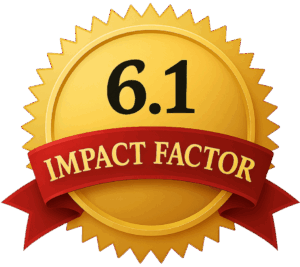
Volume 24 Issue 11 November 2024
INTERNET OF MEDICAL THINGS: BIOMEDICAL DATA MANAGEMENT AND ANALYTICS FOR ELECTRONICS HEALTH RECORD
Big Data Analytics and IoT are raising fields as of late and an enormous measure of information is created regularly so that dealing with this information is vital to be sure. The information being gathered should be examined and experiences got can be profited from the vast majority of the associations. IoMT gadgets are turning into a piece of biomedical application from patient checking frameworks, advanced mechanics medical care, wearable gadgets and so forth, The IoT innovation is truly advantageous to specialists and patients because of their fluctuated medical services applications. Since an immense measure of information is communicated step by step there is plausible misinterpretation used to happen. The prominent one is that the electrical movement of cerebrum observing is proposed yet not executed. Medical care experts have additionally benefited by this online and electronic stages to further develop their clinical works on utilizing programmed updates, prompts with respect to inoculations and malignant growth screening and so forth, Numerous associations are going to AI, to utilize these information archives and furthermore these information is isolated into organized and unstructured information. Organized information can be approved and deciphered effectively dissimilar to unstructured information. Unstructured information needs computational handling and henceforth Natural Language Processing (NLP) has advanced with the goal that the equivalent is one of the strategies for handling unstructured text notes. The volume of information in the medical care industry is expanding continually thus Data digitization can defeat this issue. The improvement of EHRs (Electronic Health Record) has an upgraded way in the total clinical record of a patient. Huge Data Analysis assembles another way to deal with medical services frameworks that possesses to appraise the sensible energy for making reasonable discretions, put together future perspectives and expand time esteem. EHRs additionally give proper information in regards to the quality consideration of worker medical coverage programs and can assist with controlling the expanding expenses of protection benefits. At last, EHRs can decrease or massively annihilate deferrals and perplexity in the charging and claims organization region. This is the explanation which caused Data examination to develop at its top lately and has helped in settling on better choices and too this likewise helped in arranging the board and estimations of the medical care industry. One significant region where examination can streamline endeavors is the administration of emergency clinic, establishment gifts and awards. Gifts are the premise of their yearly spending plans, so arranging and following costs is significant for defining proper objectives. Besides, it helps in following contributor commitment.
Mr.P.Mathivanan, Dr.K.Mahalakshmi, Mrs.D.MohanaPriya , Mrs.S.Pavithra (2024). INTERNET OF MEDICAL THINGS: BIOMEDICAL DATA MANAGEMENT AND ANALYTICS FOR ELECTRONICS HEALTH RECORD. Research Paper, 24(11), 1-25. http://journaleit.org/wp-content/uploads/1_Nov_2024.pdf
AN APPROACH FOR HUMAN ACTIVITY RECOGNITION USING SUPERVISED MACHINE LEARNING
In this paper ,we are trying to build a classification model which will recognise the activities through the mobile sensor like walking ,walking_upstairs ,walking_downstairs ,sitting ,standing,lying.The topic Human Activity recognition is in research and has its own advantages like anomaly detection, for healthy diet maintenance fitness bands are used , measuring stress level ,for monitoring employees ,for heartbeat pulse rate etc. We are going to focus on the dataset which was carried out through experiments with a group of 30 volunteers wearing a smartphone on the waist. Using its embedded accelerometer and gyroscope.The experiments have been video-recorded to label the data manually.The main motto is to use the dataset and work with the libraries like scikit learn and machine learning related libraries and algorithms while training
Madhavi Jangam, R.Hajare (2024). AN APPROACH FOR HUMAN ACTIVITY RECOGNITION USING SUPERVISED MACHINE LEARNING. Research Paper, 24(11), 26-42. http://journaleit.org/wp-content/uploads/2_Nov_2024.pdf
Experimental Study On Durability Strengthening Of Concrete By Using Industry Metal Slag Waste Partially Replacement Of Fine Aggregate
This paper present result of an experimental investigation carried out to evaluate effects of replacing aggregates (course& fine) with that of Slag (Crystallized & Granular) which is an industrial waste by product on concrete strength properties by using Taguchi’s approach of optimization. Whole study was done in three phases, in the first phase natural coarse aggregate was replaced by crystallized slag coarse aggregate keeping fine aggregate (natural sand) common in all the mixes, in the second phase fine aggregate (natural sand) was replaced by granular slag keeping natural coarse aggregate common in all the mixes and in the third phase both the aggregates were replaced by crystallized & granular aggregates. The study concluded that compressive strength of concrete did not improve almost all the % replacements of normal crushed coarse aggregate with crystallized slag by 5% to 7%. In case of replacements of fine aggregate and both type of aggregates, the strength improvements were notably noticed at 30% to 50% replacement level. It could also be said that full substitution of slag aggregate with normal crushed coarse aggregate improved the flexure and split tensile strength by 6% to 8% at all replacements and in case of replacing fine aggregate & both the aggregates( Fine & coarse) with slag, the strength improvement was at 30% to 50% replacements. It is evident from the investigation that Taguchi approach for optimization helped in indentifying the factors affecting the final outcomes. Based on the overall observations, it could be recommended that Slag could be effectively utilized as coarse & fine aggregates in all concrete applications.
B.ANTONY PRADEEP (2024). Experimental Study On Durability Strengthening Of Concrete By Using Industry Metal Slag Waste Partially Replacement Of Fine Aggregate. Research Paper, 24(11), 43-52. http://journaleit.org/wp-content/uploads/3_Nov_2024.pdf
Investigate the effect of process variables on the mechanical behavior of aluminum composites using the Friction Stir Process
The aim of this research is to provide a thorough elaboration of metal matrix composite manufacturing using various combinations of reinforcements and the principles of friction stir technique, as well as the effect of the input process parameter on material characteristics, as conducted by various research groups. The investigators began to look for a link between the experimental parameters and the output responses. Friction stir welding and processing use a fraction of the energy of other processes. The metal matrix composites replace regular used materials for many engineering applications with their unique mechanical and metallurgical properties, strength, durability, corrosion resistance. The friction stir process's process parameters, which include rotational speed, tilt angle, feed rate, and deposition rate, have a significant impact on the mechanical properties of fabricated composite surfaces. The solid state nature of the processing method has resulted in an improvement in various properties in surface composites. The pin profile also affects mechanical characteristics significantly. On surface composites, the current study will provide a concept for a defect-free weld with higher and improved mechanical properties.
V. Jaipal Reddy, K.V. Kasi Viswanadham, M. Venkateswar Reddy, G. Sreenivasulu Reddy (2024). Investigate the effect of process variables on the mechanical behavior of aluminum composites using the Friction Stir Process. Research Paper, 24(11), 53-58. http://journaleit.org/wp-content/uploads/4_Nov_2024.pdf
Network Capability in Localizing Node Failures via End-to-End Path Measurements
We investigate the capability of localizing node failures in communication networks from binary states (normal/ failed) of end-to-end paths. Given a set of nodes of interest, uniquely localizing failures within this set requires that different observable path states associate with different node failure events. However, this condition is difficult to test on large networks due to the need to enumerate all possible node failures. Our first contribution is a set of sufficient/necessary conditions for identifying a bounded number of failures within an arbitrary node set that can be tested in polynomial time. In addition to network topology and locations of monitors, our conditions also incorporate constraints imposed by the probing mechanism used. We consider three probing mechanisms that differ according to whether measurement paths are (i) arbitrarily controllable, (ii) controllable but cycle-free, or (iii) uncontrollable (determined by the default routing protocol). Our second contribution is to quantify the capability of failure localization through (1) the maximum number of failures (anywhere in the network) such that failures within a given node set can be uniquely localized, and (2) the largest node set within which failures can be uniquely localized under a given bound on the total number of failures. Both measures in (1– 2) can be converted into functions of a per-node property, which can be computed efficiently based on the above sufficient/necessary conditions. We demonstrate how measures (1–2) proposed for quantifying failure localization capability can be used to evaluate the impact of various parameters, including topology, number of monitors, and probing mechanisms.
T Jayasree, V Venkata Rakesh Reddy, L Mohan Reddy, M Nagarjuna Reddy (2024). Network Capability in Localizing Node Failures via End-to-End Path Measurements. Research Paper, 24(11), 59-66. http://journaleit.org/wp-content/uploads/5_Nov_2024.pdf
QUESTION-ANSWERING MACHINE LEARNING MODEL FOR COVID-19
Covid-19 pandemic outbreak has affected everyone of our lives directly or indirectly. There is a lot of information and an equally good amount of misinformation filled out there on the internet. The only way we can mitigate the Covid-19 crisis and keep ourselves in a healthy condition is to be informed with the right information. Whatsapp forwards, YouTube clickbait videos have made the situation worse by propagating misinformation. Governments and NGOs are trying to give out the right information but these misinformation carriers have got more reach and popularity. In this thesis, I tried to come up with a machine learning model that would act as a question answering engine for Covid-19 queries. The Question answer engine is built on the Covid-19 Open Research Dataset (CORD-19 dataset in short), the largest open dataset corpus of Covid- 19 related research papers which is developed by Allen Institute for AI as one of the training datasets. Bidirectional Encoder Representations from Transformers (BERT), Global Vectors for Word Representation (GloVe) and Generative Pre-trained Transformer 3 (GPT-3) models were used to create required embeddings. The model combines Covid-19 related research texts’ mining and leverages the famed GPT-3 models capabilities with Natural Language Processing(NLP) tools to give a better set of answers than the previously known information retrieval Question Answering Systems. Evaluation of the model is done through comparison with a manually created dataset with accurate information based on reliable sources like WHO. It is hoped that the Machine Learning Model created through this research study would be able to help researchers and common people alike in their search for accurate knowledge and information..
RAHIMANUDDIN SHAIK, Dr.V NAGAGOPIRAJU (2024). QUESTION-ANSWERING MACHINE LEARNING MODEL FOR COVID-19. Research Paper, 24(11), 67-90. http://journaleit.org/wp-content/uploads/6_Nov_2024.pdf
Automatic Irrigation System Using IoT & pH Sensor
In the present days, the farmers are suffering from severe drought like condition throughout the year. The main objective of this paper is to provide a system leads to automatic irrigation thereby saving time, money & power of the farmers, gardeners in greenhouses etc. Manual intervention is common in traditional farm-land irrigation techniques. This paper presents a technique for Arduino based Automatic Irrigation System. With this automated technology of irrigation, human intervention can be minimized. The moisture sensors is the main component which describe the soil pH property describing the degree of the acidity or basicity, which affects nutrient availability and ultimately plant growth. Thus, the system will provide automation, remote controlling and increased efficiency.
Deepak Garg, Rajeev Pandey, Ayush, Garima, Ayush, Ayush (2024). Automatic Irrigation System Using IoT & pH Sensor. Research Paper, 24(11), 91-95. http://journaleit.org/wp-content/uploads/7_Nov_2024.pdf

